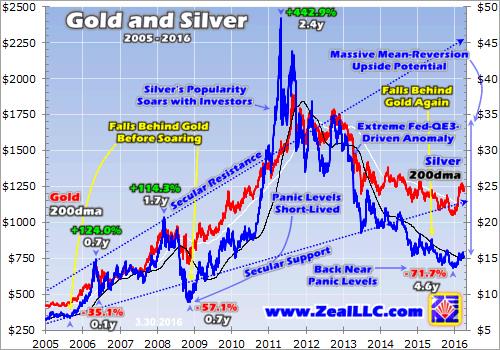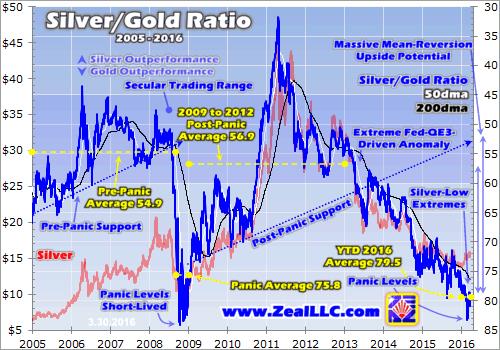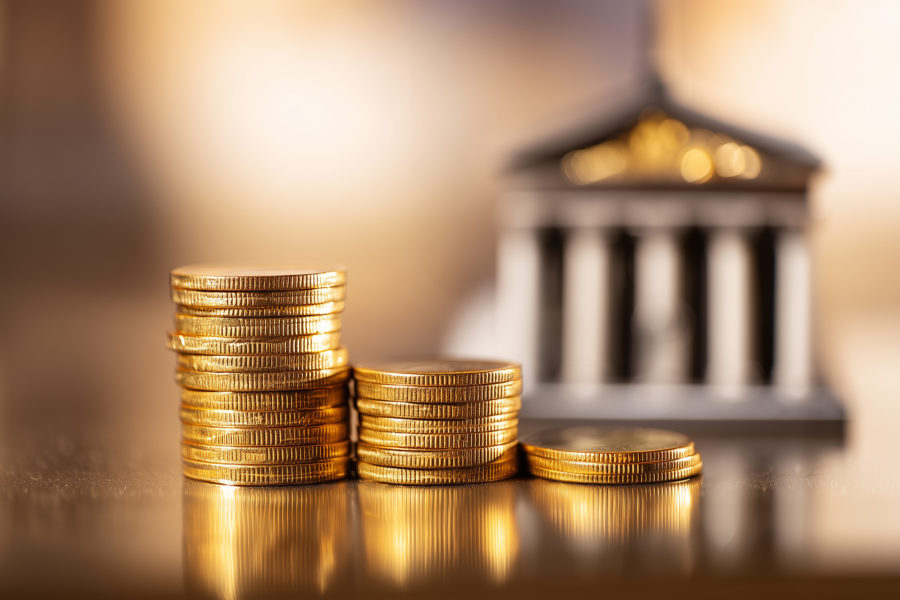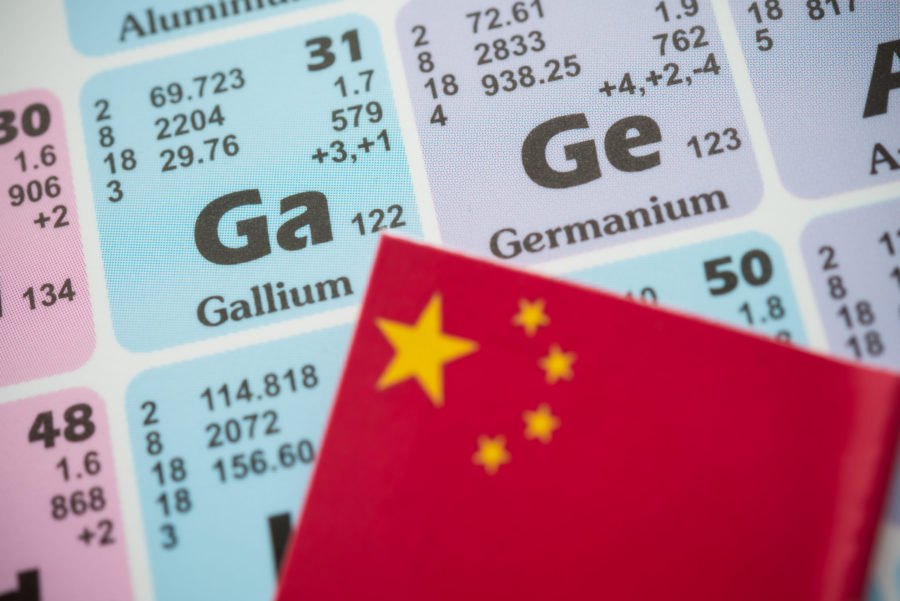Silver is coiled spring
Silver’s reluctant, sluggish participation in early 2016’s powerful gold rally has been glaringly obvious. Instead of amplifying the yellow metal’s big gains as in the past, silver largely failed to even keep pace. The lack of silver confirmation for gold’s big move has certainly raised concerns. But despite silver’s vexing torpidity in recent months, it is a coiled spring ready to explode higher to catch and surpass gold.
Silver has always been something of an investing enigma, somehow combining attributes of a highly-speculative investment, a conventional industrial commodity, and an alternative currency. Silver trades like each from time to time, stymieing attempts to classify it. Silver tends to grind sideways boringly for long periods of time, and then skyrocket higher in bulls of such magnitude that they are celebrated for years.
Silver’s primary driver has always been the price of gold. While silver can decouple over the short term, these two precious metals have very-high correlations across most multi-year spans. This is the result of silver’s unique supply-and-demand profile. Silver’s industrial demand, including all fabrication, jewelry, and silverware, accounts for around 4/5ths of total global demand. This tends to be fairly constant over time.
Thus the relatively-static lion’s share of silver demand has little impact on its price. But while investing is responsible for just the other 1/5th, it varies wildly depending on sentiment. So it effectively sets silver’s price at the margin. And the overwhelmingly-dominant driver of how bullish or bearish investors feel about silver is the price of gold. Silver effectively acts like a gold sentiment gauge, mirroring gold’s action.
When gold is climbing decisively and investors believe its rally is sustainable, they tend to flock back to silver. And since silver is such a tiny market in capital terms, relatively-small inflows can drive utterly massive price surges. 2014’s total world demand of 1067m ounces per the Silver Institute was worth just $20.3b at 2014 average silver prices. That’s practically a rounding error compared to the global capital markets!
The World Gold Council pegged global gold demand at 4226.4 metric tons in 2014. At the average gold price that year, that was worth $172.0b. So with the world silver market being less than 1/8th the size of the world gold market, all investor silver buying and selling has a price impact on the order of 8x what it would in gold. So silver can easily move disproportionately far and fast once gold gets investors excited again.
The problem is 2016’s powerful gold rally hasn’t translated into enough investor excitement to generate a substantial bid for silver. As of mid-March, silver was only up 12.5% year-to-date compared to 19.9% for gold. Normally during big gold bull runs, silver amplifies gold’s upside since its market is so much smaller. Silver can generally be expected to double gold’s underlying gains over time, a far cry from 2016’s action.
So what does silver’s serious early-year underperformance mean? Some argue that the lack of silver confirmation for gold’s strong surge is a warning sign that the latter isn’t sustainable. But that is extremely unlikely given gold’s strong fundamental underpinning of massive new investment buying. Far more likely is silver is just lagging gold, which isn’t uncommon as this secular gold and silver chart shows.

While gold is absolutely silver’s primary driver mathematically, this critical relationship gets delayed after secular gold-price extremes. That’s because the gold/silver link isn’t mechanical, but psychological. It takes time for major gold trend reversals to sink in with silver investors. They don’t ramp their buying and selling to outsized silver-moving levels until they really believe that gold’s new trend is well-established.
This delayed silver reaction to major new gold uptrends is readily evident over the past decade or so. During gold corrections and bear markets, silver amplifies gold’s downside to ultimately fall considerably farther. That leaves silver sentiment very bearish when gold is bottoming. So recently-burned investors are loath to return in gold’s initial rally. Their outlook tainted by fear and despair, they doubt gold’s run will last.
But once gold rallies far enough for long enough to convince silver investors that the bottom really is in, and the new upleg is sustainable, they start redeploying in silver. This is slow at first, but as silver’s own price is driven higher more and more capital returns. Nothing begets buying like buying, everyone loves a winner. Then as silver’s gains accelerate, they soon catch up with and eventually surpass gold’s own.
This pattern happened multiple times in the late 2000s. As you can see above, silver fell far behind gold as the yellow metal corrected or consolidated. With gold no longer rallying, investors’ interest in owning silver waned. But soon after gold bottomed and started powering higher again, silver caught a massive bid and ultimately surged much faster and higher than gold. This has long been the typical silver-upleg pattern.
And this same bearish silver-price lead-in to a major secular gold low unfolded again in recent years, at an exceptionally-large scale. Between gold’s secular-bull peak back in August 2011 and its secular-bear bottom in December 2015, it plunged 44.5%. Silver greatly amplified that secular gold bear, with a 68.7% plummet over that same span. Such horrendous losses decimated the ranks of silver investors.
This is easiest to see in the silver-bullion holdings of the world-leading iShares Silver Trust silver ETF. Unlike most silver supply-and-demand data that is available just once a year or quarterly at best, SLV’s managers publish its bullion holdings every day. SLV is effectively a conduit for stock-market capital to flow into and out of physical silver bullion, so its holdings are a great proxy for stock investors’ silver exposure.
Back in August 2011 when gold peaked, silver was trading just under $44 and SLV held 313.9m ounces of silver in trust for its shareholders. That works out to about $13.7b of silver. But by mid-December 2015 the day after the Fed’s rate hike when gold slumped to a dismal 6.1-year secular low, silver was priced under $14 and SLV held 323.5m ounces. So there was only $4.4b of stock-market capital invested in silver.
Naturally silver-investor morale was atrocious as gold was bottoming late last year. Heading into that first Fed rate hike in 9.5 years, there was a universal belief that a new Fed-rate-hike cycle would prove devastating for zero-yielding gold. Never mind that history proves just the opposite, that gold thrives in Fed-rate-hike cycles! With everyone expecting gold to spiral lower, no one wanted anything to do with silver.
The longer bearish sentiment remains, and the more extreme it gets, the more inertia it has and the harder it is to turn. And with silver slumping to a brutal 6.4-year secular low of its own in mid-December, it was going to take some time to convince battered silver investors to return. I suspect that natural delay in sentiment shifting following an extreme is why silver has lagged gold’s powerful rally in 2016’s initial months.
They certainly weren’t ready to jump back into silver at the first signs of a gold advance, as a half-dozen sharp gold rallies had soon failed in recent years. They were driven by speculators buying gold futures, which soon exhausted itself. Gold rallies can only grow into uplegs and new bull markets if investors with their vastly-larger pools of capital soon step in to take the buying baton from futures speculators.
And gold’s massive new investment buying this year, unlike anything seen since early 2009, really was not fully evident until late February. So it’s understandable that silver investors remained skeptical of the initial couple months of gold’s new rally, as that was within the timeframe where it could still be driven solely by futures speculators. As March rolled around, investors finally started to return to silver again.
This is evident in the silver-bullion holdings of SLV. By the end of February, they had slipped by 2.0% in 2016. Stock investors weren’t the least-bit interested in silver. This was a sharp contrast to the gold-bullion holdings of the leading GLD gold ETF, which soared 21.0% year-to-date in that same span. But silver investors finally started to return in March, where SLV’s holdings surged 6.0% by late in the month.
So after falling behind gold again following a major secular low, capital is starting to flow back into silver. Investors are starting to understand that 2016’s gold rally is very different from anything in recent years with its strong investor participation. So they are finally starting to believe this new gold bull is righteous and sustainable. Yet again, silver is fulfilling its traditional role of acting as a sentiment gauge for gold.
And it’s not just gold sentiment that impacts silver, certainly one of the most speculative investments out there. Silver has also long had a tendency to be affected by significant stock-market action, especially to the downside. Historically when stock markets sell off notably on any trading day, silver is often sucked in. On days when stocks are down and gold is up, silver tends to split the difference instead of following gold.
Stock-market selloffs significant enough to capture investors’ attention have a universal dampening effect on the willingness to take risk. That’s why they’re often called “risk-off” days. And silver seems to be far more susceptible to that than gold, since it is far more speculative. So a second reason that silver has lagged gold so much in 2016 was the sharp general-stock selloff in the first 6 weeks of this year.
I’ve observed this silver-following-general-stock-down-days phenomenon for years, but it’s difficult to quantify since the gold action also affects silver on those days. But it definitely exists. Silver certainly isn’t the only commodity affected by pessimistic stock-market sentiment. Crude oil has also always had a strong correlation with stock-market selloffs. Stock-market fortunes exert a powerful universal influence.
With silver finally starting to respond to gold’s powerful 2016 rally, its upside potential is truly massive. This next chart looks at the Silver/Gold Ratio, or more precisely the inverted Gold/Silver Ratio. It is effectively the same thing, but with cleaner easier-to-read numbers than the true SGR’s tiny decimals. Silver fell so far out of favor last year that it remains extremely undervalued relative to gold, making it a coiled spring.

So far in 2016, the SGR has averaged 79.5. In other words, it takes 79.5 ounces of silver to equal the value of a single ounce of gold. Since gold is silver’s dominant driver, these metals’ prices have always been closely related. The SGR quantifies this critical relationship, and is actually an outstanding trading tool. It reveals when silver is undervalued or overvalued relative to gold, ideal times to buy low and sell high.
Before 2008’s once-in-a-century stock panic, the SGR averaged 54.9. That’s a good baseline of where silver should be trading relative to gold on average in modern markets. During 2008’s stock panic, the strong tendency of silver to be sucked into exceptional stock-market down days flared with a vengeance. So silver plummeted far faster than gold as stock markets collapsed, blasting the SGR to unsustainable extremes.
During the last 4 months of 2008 within that stock panic, the SGR averaged 75.8. Silver was radically undervalued relative to gold, an incredible buy. As I pointed out at the time to our subscribers, and later explained in an essay in early 2009, silver simply couldn’t sustain such extreme lows relative to gold. As is always the case after such a ratio hits extremes, a normalizing mean reversion the other way is inevitable.
And indeed that soon came to pass just as expected. Silver prices rocketed far faster than gold’s in 2009 emerging from that epic stock panic. But like most mean reversions out of extremes, they didn’t simply stop at the previous 54.9 average. In mid-2010 silver finally started to regain popularity with investors so they threw capital at it in a big way. So silver skyrocketed to the opposite extreme in early 2011, radically overshooting.
Over that entire 2009-to-2012 span, the normal years sandwiched between 2008’s crazy stock panic and the Fed’s wildly-distorting QE3 campaign ramping to full steam in early 2013, the SGR averaged 56.9. Interestingly that is right in line with the pre-panic average, and close to the 55 SGR that the gold miners and silver miners had long used to convert their byproduct to equivalent ounces of their primary metal.
Between 2013 and 2015, the Fed’s unprecedented open-ended QE3 campaign levitated stock markets. Each time they threatened to sell off, Fed officials were quick to step in and imply they were ready to expand QE if necessary. Investors interpreted this as a Fed Put, so capital migrated from everything else into the seemingly-perpetually-rising stock markets. Demand for alternative investments led by gold just collapsed.
And being driven by gold, silver followed it lower in recent years. But being highly-speculative, as well as tending to amplify gold, silver prices fell a lot farther than gold’s. So far in 2016, silver has been so low relative to gold that the SGR is averaging just 79.5. Thus silver has actually been cheaper relative to gold this year than during 2008’s once-in-a-lifetime stock panic! Such an incredible anomaly can’t persist.
So today silver looks even more bullish than it was in late 2008, which is amazing. From its November 2008 panic low to its euphoric blow-off top in April 2011, silver soared 443% higher in 2.4 years! There’s no doubt a similar mighty bull market is very possible off of mid-December 2015’s secular low. A similar gain would ultimately catapult silver prices above $74 per ounce in another popular-speculative-mania scenario!
While an overshoot after the inevitable mean reversion out of 2016’s extreme silver lows is inevitable, there’s no need to expect such a radical one to be bullish on silver. Silver will have no problem at all returning to its 2009-to-2012 average levels near 1/57th the price of gold. At $1250 gold, that yields a silver price target near $22. That’s another 44% above today’s levels, a solid gain no one would sneeze at.
But gold itself is also mean reverting out of the extreme Fed-conjured distortions of recent years, heading far higher. During 2012 before the Fed’s stock-market-levitating QE3 ramped to full steam, the gold price averaged $1669. At that price and the post-panic-average 56.9 SGR, silver would be priced above $29 again! That’s 93% higher than today’s levels. And seeing silver back up there really isn’t a stretch at all.
Silver first went above $29 in December 2010 as it regained popularity with investors. Then it essentially stayed above $29 until March 2013 when the Fed’s QE3 was starting to hammer gold. So there is plenty of modern precedent for silver being priced far higher than it is today. The weak late-2015 silver prices that seem normal now are as big of anomaly as they were during 2008’s stock panic, it simply can’t last.
All it takes for silver to surge dramatically is for a relatively-small fraction of investors to migrate a trivial amount of capital in the grand scheme of the markets back into this white metal. Like everything else in the markets, silver is forever cyclical. It gradually oscillates from out of favor to into favor. And the higher investors push silver, the more attractive silver becomes attracting in even more capital. Buying begets buying.
With silver due for a massive mean reversion higher this year as gold’s new investor-fueled bull market continues to grow, there’s rarely been a better time to buy silver. Investors can buy physical silver bars and coins, or that flagship SLV silver ETF. But silver’s coming gains will be dwarfed by those in the beaten-down silver miners. Their profits leverage to silver’s price is extreme, granting them epic upside potential.
At Zeal we’ve long specialized in the contrarian gold-stock and silver-stock realms. Over the decades we’ve done many hundreds of these trades, earning fortunes for our subscribers. And unlike most other analysts, we didn’t capitulate and abandon silver and silver-stock research in the recent dark years. As we don’t have to spend years getting back up to speed, our unparalleled knowledge is exceptionally valuable.
You can put our great expertise to work for you with our acclaimed weekly and monthly contrarian newsletters. They draw on our vast experience, knowledge, wisdom, and ongoing research to explain what’s going on in the markets, why, and how to trade them with specific stocks. We aggressively added new trades in recent months, with many already having unrealized gains ranging from 50% to 150%+! At just $10 an issue, you can’t afford not to subscribe. Join us today, support our research, and enjoy our popular 20%-off sale!
The bottom line is silver is a coiled spring today ready to explode higher. Silver was battered so low in recent years’ gold bear that it’s spent 2016 trading near stock-panic levels relative to gold. Such super-low prices aren’t sustainable, so silver is due for a massive mean reversion higher as investors start to return. Their lagging buying finally began in March, and will soon accelerate and become self-feeding.
These big new capital inflows squeezing into such a small market will drive up silver prices faster than gold’s. As silver’s new bull catches up with and then surpasses gold’s, the SGR will gradually normalize. Naturally much-higher silver prices will work wonders for the left-for-dead silver miners’ stocks. Coming off of late 2015’s extreme secular lows, their gains in the coming years will certainly prove breathtaking.
Adam Hamilton, CPA
More News
Is Basel III setting up a new gold-backed monetary system?
April 20, 2025 | 08:22 am
China’s export controls are curbing critical mineral shipments to the world
April 20, 2025 | 08:15 am
{{ commodity.name }}
{{ post.title }}
{{ post.date }}




Comments